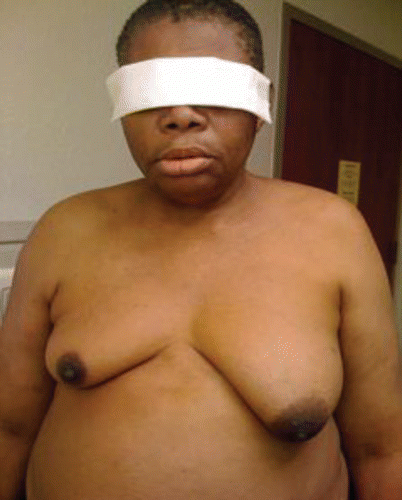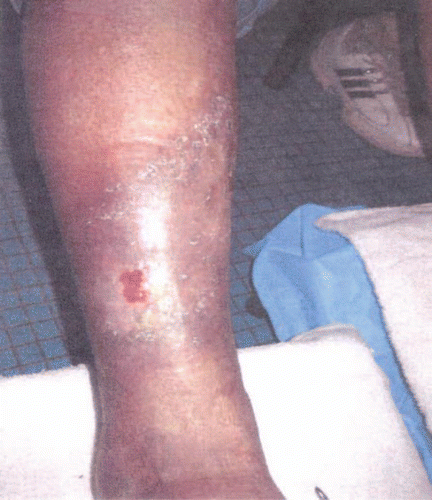Abstract
Klinefelter syndrome (KS) is the most common genetic form of male hypogonadism. The majority (80-90%) of patients have 47, XXY karyotype while mosaicism is seen in only 10-20% of patients. Leg ulcers may be a presenting symptom of KS with a prevalence of 6-13%. Treatment with testosterone has been reported to improve the ulcers.
Introduction
Klinefelter syndrome (KS) is characterized by hypergonadotropic hypogonadism. Patients usually present with symptoms of low testosterone such as erectile dysfunction, poor libido and infertility. Men with mosaicism are less affected and often are not diagnosed. Leg ulcers may be a presenting symptom of KS. Here, we report a case of undiagnosed mosaic KS presenting with non-healing bilateral leg ulcers.
Case Report
A 58-year-old man was referred to our endocrine clinic for evaluation of long standing erectile dysfunction which had not been previously investigated. His medical history was significant for bilateral leg ulcers with no improvement despite compression wound care therapy for 5 years. He denied tobacco abuse. Physical examination revealed marked obesity (BMI 33), sparse hair on the face and body, bilateral gynecomastia (), gynecoid habitus, micropenis, small testes, chronic venous ulcers () and hyperpigmentation on both lower extremities. Routine laboratory examination did not show any evidence of diabetes. Hormonal evaluation revealed a testosterone level of 12 (350–890 ng/dl), follicle stimulating hormone (FSH) of 40 (1.2–19.26 mIU/mL), luteinizing hormone (LH) of 24 (1.2–8.62 mIU/mL), prolactin of 7.5 (2.6–13) ng/mL and estradiol of <10 pg/mL. Testing for hypercoaguable disorder was negative for any abnormalities in protein C, protein S, antithrombin III, lupus anticoagulant, anticardiolipin antibody, Factor V Leiden mutation and prothrombin gene mutation. Doppler ultrasound of the legs did not show any evidence of deep venous thrombosis. Chromosomal analysis revealed a 47, XXY/46, XY/48, XXXY/46, XX karyotype which was diagnostic for mosaic Klinefelter syndrome (KS). He was begun on androgen replacement therapy and his repeat total testosterone was 591 ng/dl, FSH was 10.6 mIU/mL and LH was 16.6 mIU/mL. The plasminogen activator inhibitor (PAI-1) was low, however this was measured after treament. The patient noted healing of his leg ulcers within 6 months of treatment with androgen therapy ().
Discussion
KS is characterized by hypergonadotropic hypogonadism. Leg ulcers may be a presenting symptom of KS with a prevalence of 6–13%. Men with mosaicism often remain undiagnosed, as was our patient. Elevation of plasminogen activator inhibitor-1 (PAI-1) may play a role in the pathogenesis of leg ulcers since it inhibits plasminogen activator (PA) and urokinase which activate breakdown of fibrin.
Leg ulceration in KS results from a combination of reduced testosterone levels, obesity and chronic venous insufficiency. Treatment with testosterone has been reported to improve the ulcers by reducing PAI-1 levels.
We think that it is important for the dermatologists to recognize the association between venous leg ulcers and Klinefelter syndrome as these patients are likely to present to them with complaints of skin ulcers. KS should be considered in the differential diagnosis of non-healing venous ulcers in male patients with eunuchoid body habitus and erectile dysfunction in whom the cause of the ulcers cannot be otherwise explained, as androgen replacement therapy promotes better healing of ulcers in these patients.
Disclosure of Potential Conflicts of Interest
No potential conflicts of interest were disclosed.
Abbreviations
| KS | = | klinefelter syndrome |
| BMI | = | body mass index |
| FSH | = | follicle stimulating hormone |
| LH | = | luteinizing hormone |
| hCG | = | human chorionic gonadotropin |
| PAI | = | plasminogen activator inhibitor |
| PA | = | plasminogen activator |
References
- Klinefelter HF, Reifenstein EC, Albright F. Syndrome characterized by gynecomastia, aspermatogenesis without aleydigism and increased excretion of follicle-stimulating hormone. J Clin Endocrinol 1942; 2:615 - 627
- Veraart JC, Hamulyak K, Neumann HA, et al. Increased plasma activity of plasminogen activator inhibitor (PAI-1) in two patients with Klinefelter's syndrome complicated by leg ulcers. Br J Dermatol 1994; 130:641 - 644
- Ibbotson SH, Layton AM, Davies JA, et al. Plasminogen activator inhibitor 1 (PAI-1) levels in patients with chronic venous leg ulceration. Br J Dermatol 1994; 131:738 - 739
- Veraart JC, Hamulyak K, Neumann HA. Klinefelter's syndrome as a model for skin changes in venous insufficiency. Wien Med Wochenschr 1994; 144:277 - 278
- Villemur B, Truche H, Pernod G, et al. Leg ulcer and Klinefelter syndrome. J Mal Vasc 1995; 20:215 - 218
- Aollner T, Veraart J, Wolter M, et al. Leg ulcers in Klinefelter's syndrome—further evidence for an involvement of plasminogen activator inhibitor-1. Br J Dermatol 1997; 136:341 - 344
- Igawa K, Nishioka K. Leg ulcer in Klinefelter's syndrome. J Eur Acad Dermatol Venereol 2003; 17:62 - 64
- De Morentin HM, Dodiuk-Gad RP, Brenner S. Klinefelter's Syndrome presenting with leg ulcers. Skinmed 2004; 3:274 - 278
- Gattringer C, Scheurecker C, Höpfl R, Müller H. Association between venous leg ulcers and sex chromosome anomalies in men. Acta Derm Venereol 2010; 90:612 - 615


